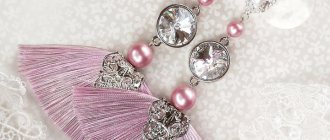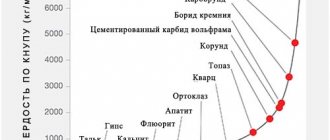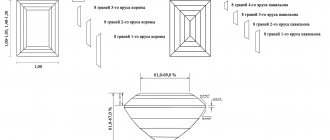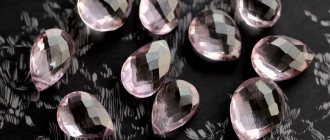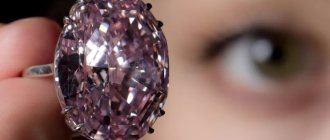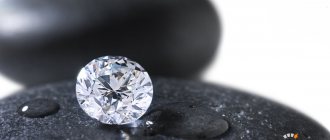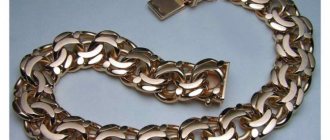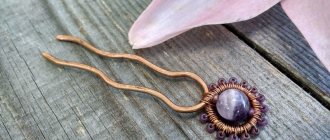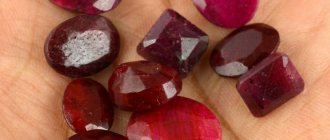Diamond is the hardest material in nature. Everyone knows that in order to get a diamond, the diamond is processed. But how can this be done, since this requires even harder materials? How are diamonds processed to make polished diamonds?
In fact, there are limits to the hardness of a diamond; it is different in different directions, so if you choose the right angle at which the cutting tool is directed towards the diamond, you can get acceptable results. In addition, quite a long time ago people realized that only another diamond or its fragment is suitable for these purposes.
Diamond cut
Diamond is highly crystallized carbon whose atoms have a geometric organization that allows pieces of diamond to be broken off parallel to the plane formed by the atoms. With this treatment, the surface becomes even and smooth.
Before diamond processing begins, the craftsman must study its internal structure. Any incorrectly calculated inclusion or crack can cause the stone to split during the cutting process. Diamond defects are assessed manually using a magnifying glass. Depending on the value and size of the stone, this process can take from several days to several years.
If the diamond has a matte surface, then before starting work, one side of it is polished so that its internal structure can be assessed. After this, if it is necessary to split the stone, split lines can be drawn with ink.
What is a diamond cut
Diamond cutting is an important and necessary process of transforming a diamond into a luxurious gem. An uncut crystal cannot be inserted into a piece of jewelry; it will not have a luxurious appearance and magnificent shine.
A cutter transforms rough diamonds into diamonds by directly impacting them with special tools. All processing stages are carried out manually. This is a long and painstaking process requiring:
- precision of movements;
- perseverance;
- ability to imagine three-dimensional images of future products.
Read more about the difference between diamonds and rough diamonds in the article.
What does an uncut diamond look like?
Diamond cutting changes the natural gem dramatically. If you compare the crystal before and after the process, it is difficult to believe that it is the same stone. Giving it shape and edges makes it shine and shimmer with all the colors of the rainbow, giving it transparency.
Before cutting, a diamond looks completely different from a processed mineral:
- uneven shape;
- no shine;
- there may be inclusions, impurities;
- dark or black.
Uncut diamonds are not in mass demand, although there are individual collectors who purchase just such stones, but these are isolated cases.
Main cutting stages
The process of turning rough diamonds into polished diamonds is complex and responsible. The value of a stone is determined not only by its size, carat, color and clarity, but also by the type of cut and the work of the master jeweler. Mathematical precision is required for the crystal to sparkle with all its faces, reflecting the light falling on it.
The time it takes to process one crystal depends on:
- depending on the chosen shape - the more faces, the longer the process takes;
- size of the mineral - large ones take longer to cut, but there are small specimens that are valued more expensive than large ones due to painstaking and lengthy labor;
- the condition and newness of the equipment - the more modern it is, the faster things go;
- experience of the master - beginners are afraid to spoil the future diamond with an unnecessary movement of the hand.
The Golden Jubilee Diamond, which has 102 facets, was presented to the monarch of Thailand. It took 2 years to create it. Such instances are rare; work is usually carried out as usual. Average cutting time:
- preparation for cutting – 3–4 hours;
- sawing – a 1 carat stone needs to be sawed for 6–8 hours;
- grinding – 3–4 hours;
- polishing – 1–2 hours.
It turns out that it takes from 13 to 24 hours of continuous labor to create one diamond, which is 2-3 working days.
View this post on Instagram
Posted by about_royal_jewellery (@about_royal_jewellery) Nov 3, 2022 at 9:25 am PDT
How are diamonds processed?
Diamond cutting is complicated by the hardness of the mineral - 10 out of 10 on the Mohs scale. For each stage of production, certain devices are used.
- Diamond cutting is carried out using a laser or diamond saw, the rotation speed of which reaches 9000 revolutions per minute.
- Peeling is done with a diamond cutter; this is rough processing, during which contours and future edges are outlined. This produces diamond dust, which is used in the production of diamonds.
- Cast iron discs are used for grinding, which barely touch the crystal when rotating. First, the upper and then the lower facets (beveled side edges) are polished.
- Polishing is carried out using a horizontally positioned iron polishing wheel. From time to time, the product is washed with water to remove waste and shavings.
- The final stage is boiling in sulfuric acid. This cleans the diamond of dirt, oil, and diamond powder.
Study of internal structure
Diamond processing begins with the master studying the internal structure. You don't always come across perfect stones. They may contain foreign inclusions and cracks. If you start working with him, it will lead to a split. Such valuable materials cannot be allowed to be discarded.
All defects can be seen with an experienced eye using a magnifying glass. Diamond cutting production does not require high speed of work. Detecting deficiencies is a painstaking process and lasts more than one day. It all depends on the size of the stone and its value.
To see everything as accurately as possible, you need the sides to be transparent. If it happens that part of the stone has a matte surface, then it is ground to evaluate the internal structure. Sometimes it may be necessary to split the stone, as not every piece of jewelry requires large diamonds.
Standard Diamond Processing
In the 21st century, all stages of the cutting process have been precisely developed. Science and technology make it possible to model future diamonds in 3D format by entering the necessary parameters into the program. This eliminates the need for the craftsman to determine the number, length and width of edges by eye.
There are 4 stages in the birth of a diamond. How diamonds are cut:
- The stone is scanned with X-rays, looking for cracks in it. X-rays are used to determine the exact position of the diamond in the mined rock. Based on the information received, a cut is made.
- After being separated from the rock and divided into pieces, each specimen is subjected to grinding on a specially designed lathe. This gives the stone the intended shape and the required number of edges.
- Next, the diamond is generously treated with diamond powder mixed with olive oil and polished on special iron wheels. This gives smoothness.
- Polishing completes the process. With its help, the product acquires its final shine.
In addition to watching a program about cutting in Russia:
Conclusion
This new laser processing technology eliminates the drilling channel associated with traditional laser drilling. Instead, laser treatment opens and splits tension cracks down to the surface of the diamond to allow penetration of the bleaching solution. The resulting pen has a more "natural" appearance than a traditional laser drill channel. Identification of this new laser treatment requires careful microscopic examination with various illumination techniques. These diamonds can be identified by the presence of transparent, mirror-like feathers that contain unnatural-looking irregular channels connecting internal inclusions to the surface of the stone.
Regardless of the technology used, diamond industry ethics require that such treatments be properly disclosed from the manufacturer to the end consumer.
Old processing type
The first diamond cutters were in India, they carved an octagon from a gem, which was considered a sacred ritual. By the 14th century, craftsmen appeared in Europe to carve diamonds with edges that add shine. In 1465, by order of the Duke, the first product resembling a rose-cut diamond was made.
In 1919, Marcel Tolkowsky carried out calculations and came up with two diamond cutting schemes - round and brilliant. It marked the beginning of the era of transformation of minerals into jewelry.
Since 1919, cutting has been practiced according to the development of M. Tolkovsky:
- on top there was a flat platform - the crown;
- the base tapered, almost turning into a sharp tip;
- there was a belt around the perimeter;
- the product received 57 edges.
The method was very popular - before this, the stones practically did not shine. It was used until 1965, when Arpad Neji developed a diamond processing scheme in which he increased the number of facets to 65. Then, more and more new types of cutting began to appear, driven by buyer demand for a variety of diamonds, rather than the same type.
Diamond processing has been carried out in Russia since 1963. The first one was launched in Moscow. Cutting was carried out according to the then fashionable types of round cut, “princess”, “rose”, etc.
Discussion
We believe that the three diamonds that did not show any signs of improvement (numbers 3, 7 and 8) were considered unsuitable for this process due to a lack of tensile cracks or because the dark inclusion was too deep within the diamond (again see Figure 3). It is possible that one stone (#7), which had two small dark crystals with minor tensile cracks, was not treated because these inclusions had minimal impact on the overall clarity of the stone. This would confirm our theory that the treatment is best used to eliminate dark inclusions near the surface, as was the case with the other six diamonds. The production of feathers reaching the surface from a deep inclusion is likely to cause them to be even more prominent than the original inclusion.
One of the inclusions processed in our test sample (No. 6) was located deep in the diamond, but a pen was pointed at the surface of the pavilion, which allowed it to whiten the inclusion.
Figure 13. New laser processing has expanded the feather surrounding the crystal in this stone to the surface. The pre-existing feather in this photo is very transparent, but the new area is much more reflective. Magnified 40 times.
The most significant discovery when examining our diamond samples was that the new processing process not only expands existing feathers (Figure 13), but also creates entirely new ones. The presence of a stepped pattern on some treated feathers indicates that the treatment process is very controlled. By inducing small cleavages in this stepwise pattern, processors appear to be able to attach the inclusion to the surface in the most direct way possible, even if that route does not follow the direction of cleavage in the diamond.
Figure 14. It appears that the channels shown here in the center of the light area serve to expand the feathers, allowing the penetration of acids used to bleach the inclusions. This is evidenced by the higher visibility of the areas immediately surrounding the channels. Magnified 63 times.
Figure 15. Several large feathers were present around the embedded crystal in this diamond when it was bleached. Remnants of black material are still present in several feathers. Magnified 40 times
It appears that vermiform canals were used to expand the induced feathers and are clearly visible under the microscope within the feathers that immediately surround the canals (Figure 14). This is undoubtedly done to facilitate the penetration of the acids used to bleach the inclusions. However, treatment was not always successful in removing all black material (Figure 15). This may be because the laser drilling was incorrect or because the materials being removed react differently to the bleaching process. For example, sulfides are easily destroyed by acids, but graphite is not. However, inclusion size is not an issue as we have seen diamonds in which large crystals were dissolved using this technique (Figure 16).
Figure 16. The original large crystal in this diamond was completely dissolved during processing. The induced feather created to reach the crystal is visible just above the inclusion. Notice that around the remnant of the larger crystal there are several small crystals that are still black because the feathers did not connect to them. Magnified 30 times.
Detection
Identification of this treatment, as with traditional laser procedures, depends entirely on careful microscopic examination. The diamond should be examined both face up and in a tee to culet position using a variety of lighting conditions: dark field, bright field and fiber optic illumination. Look for the presence of one or more signs when identifying. The treatment may appear as a mirror or transparent feather that extends from the inclusion to the surface of the stone, usually at an angle completely different from the direction of the pre-existing internal chip. Note that these feathers are often transparent and may not be visible under certain lighting conditions (Figure 17). Cracks themselves occur in rough diamonds, but this characteristic arrangement makes them suspicious.
Figure 17. Using different lighting conditions and different viewing angles is important in detecting this processing. The vermiform canals are clearly visible in the photo on the left, but not the induced feather in which they are located. By changing the position of the stone, light can be made to reflect off the feather so it can be easily seen (right). Enlarged 40x.
There are usually one or more small channels in the center of the cleavage plane, which can be relatively straight or very tortuous and often resemble wormholes. These channels may appear black or white in low light, but are usually dark in bright light. They are often not visible when light is reflected from the surface of the diamond's nib, indicating that they are entirely contained within the nib (Figure 18). Such channels are not seen in rough diamonds. However, in some cases the channels are so confusing that they are difficult to recognize (see Fig. 8). The treatment may also appear as a series of small stepped splits that are spaced close together and have a very unnatural appearance. As a rule, they are connected by many worm-shaped canals, which are best visible in transmitted light (see Fig. 9).
Figure 18. The internal channels are very difficult to see when light is reflected from the pen, as shown in this case in the top half of the pen nib. Note that the feather extension is still clearly visible. Magnified 40 times.
This treatment was very difficult to detect in some diamonds, both in our test samples and in those that came into the laboratory. This was usually because the distance between the inclusion and the surface of the stone was small, so the features created by the laser were small and difficult to distinguish. Additionally, if the inclusion is very close to the surface of the cut diamond, then the number of possible viewing angles is greatly reduced, further complicating the identification of such treatments.
Laboratory conclusion
GIA has disclosed information about laser drilling in its diamond grading reports since first documenting the process in 1970 (Crowningshield, 1970). To highlight its presence, "laser hole" is listed first in the symbol key in the GIA Diamond Grading and Diamond Dossier reports. In cases where laser processing methods do not produce holes that reach the surface, GIA Gem Trade Lab discloses the processing in the Comments section of its reports with the statement: “Internal laser drilling is present.”
Types of diamond cuts
The diamond market is represented by crystals of various shapes, sizes and number of faces. There are more than 30 diamond cutting options. The choice of a specific shape is based on the contour of the girdle - the thin edge that encircles the stone.
There are 3 main forms of diamond cutting, on which all existing variety was based:
- stepped - the face divides the stone into upper and lower parts, the facets are located parallel to the face, used for rectangular, trapezoidal, square gems;
- diamond – Tolkowsky cut;
- mixed - a combination of the first two.
The most common number of facets is 57, small stones can have 17 facets, square stones can have 65 and 74, and especially large stones can have 102.
Round
The most sought after and popular type of gem cutting. Extremely unprofitable for production - a lot of material is wasted on chips. The number of faces can be 17, 57.
Oval
An oval-shaped gem is used to create pendants, earrings, and rings. This type of cut is believed to impart elegance to the wearer. Earrings visually lengthen the face, and the ring - fingers. Small stones have 17 facets, larger stones have 57.
"Princess"
After cutting using this type, you get an almost perfect square, sparkling with all the colors of the rainbow. Ranks second in popularity. Mostly used in wedding rings. Disadvantage - the edge breaks off upon impact, the stone loses its strength in the setting, and is easily damaged or lost. Has 65 edges.
"Heart"
The “heart” cut of a diamond is a complicated “pear”, its wide base is forked. The cut form appeared relatively recently and quickly gained popularity. The number of sides of the heart is 57 or 58.
With such a cut, the product turns out to be fragile and can crack upon impact with the surface. To increase strength, certain proportions are used: the ratio of length to width should be 1 to 1.
"Rose"
By cutting out 24 triangular facets, the resemblance to a rosebud is achieved. This ancient type of cutting is suitable for stones as large as 2 carats. Used for rings, pendants, bracelets.
"A drop"
The second name for the cut is “pear”. Combines a round shape and a marquise cut. The diamond is shaped into a drop. Used for inlaying earrings and rings. Popular among women. Number of faces – 56.
Emerald cut diamond
After cutting the mineral into an “emerald” type, an octagonal rectangle is obtained, allowing up to 70% of the original mass of the stone to be preserved. Suitable for processing large diamonds as it reveals their transparency. 56 facets reflect light inward, causing the gem to glow.
"Usher"
The Asscher cut was invented in Belgium to cut perfectly transparent gems. Requires the use of top quality raw materials and is rarely used. It differs from the “emerald” in its square shape, has the same number of facets - 56. Maximum reflects the color and purity of the diamond.
"Cushion"
A type of “pear” cut, where there is a rounding at the top, which greatly increases the radiance of the stone. For this reason, the cushion is called a “candle diamond.” Has 72 facets. This treatment allows the weight of the original piece to be preserved as much as possible, which is why it has been popular since Baroque times to this day. The famous Tiffany diamond is cushion cut.
"Radiant"
A new type of cut, used for about 30 years. Diamonds take the shape of an equilateral triangle with rounded edges. There may be 65 or 74 facets.
Marquise diamond cutting
According to legend, the oval shape of the resulting diamonds resembles the smile of the Marquise of Pompadour, in whose honor King Louis the 14th ordered the jeweler to cut the stone. Number of faces – 55.
"Baguette" and "trillion"
Small diamonds require a special approach; they need to be given a presentable appearance while maintaining maximum weight. Baguette and trillion cuts are well suited for this.
In the Netherlands, the trillion cut method was invented, which results in a triangular-shaped diamond. Larger stones have 31, 37, 52 facets, small ones - 19. The resulting specimens are used to decorate rings and rings on the sides.
Baguette processing preserves the shape of natural stones as much as possible, which become squares, trapezoids or triangles. They are used to frame large crystals when composing compositions.
Royal cut diamond
This is a special type of round cut, characterized by the presence of 86 facets. Such specimens are extremely rarely used for making jewelry, becoming works of art. Found in private collections or museums.
What criteria are used when choosing a diamond cut?
Among the diamonds that are classified and certified, you can choose based on the quality of processing of each stone.
You can also compare diamonds based on their level of brilliance, and since this is a characteristic that is directly related to the size of the stone, you will indirectly choose a more proportional cut.
Sometimes, you can select certain proportions that suit some of your needs.
For example, for a setting that hides the bottom of the diamond, you may want to choose a stone that is cut less deeply than usual so that when set, a significant portion of its surface will be visible, making it appear larger.
Source
Types of fancy cuts
Types of cuts are divided into classic (round) and fancy (all others). The latter are divided into:
- Wedge-shaped, with a rounded upper part. These include “pear”, “radiant”, “princess”, “marquis”.
- Stepped, the facets on which are applied in tiers. These are “emerald”, “asher”, “trillion”, “baguette”, etc.
Fantasy processing allows the source material to be given any shape and opens up wide opportunities for the realization of talent for creating masterpieces.
Which cut type do you find most attractive? What looks better in a ring – a square or a rose? Share the article with your friends and acquaintances, the information may be useful.
What color should a diamond be?
What colors
There are
diamonds.
The most valuable are completely colorless diamonds
or with a tint of blue, as well as with bright fancy colors - blue, pink, red, yellow, green, etc., but most mined diamonds have yellow, brown or sulfur shades of varying intensities.
Interesting materials:
Why does freon destroy the ozone layer? Why is the cheetah the fastest? Why did Gerasimov drown Mumu? Why is Germany and the inhabitants are Germans? Why do the eagle heads on the coat of arms point in different directions? Why is hot air lighter than cold air? Why is cooked meat pink? Why do they say China is the Celestial Empire? Why do they say Celestial Empire? Why do they say spouse?
